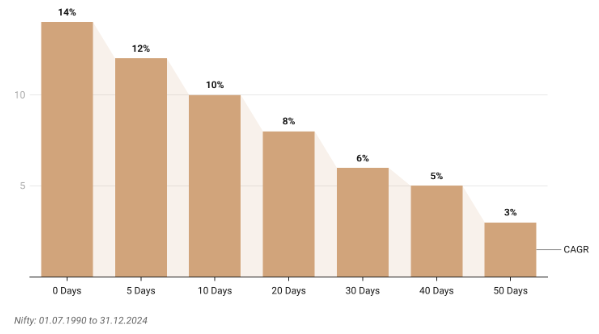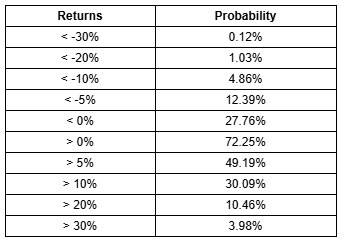When markets become unpredictable, it feels natural to want to move your money into cash, like finding safety during a storm. But in investing, this choice often ends up being a mistake. Let’s explain why moving your money to cash not only fails to protect your wealth but can reduce it over time.
The Myth of Market Timing
Market timing is like catching lightning in a bottle. The idea sounds appealing: sell at the peak, buy at the bottom, and repeat.
Why Timing the Market is a Losing Game
Timing the markets is notoriously difficult – even for seasoned investors:
Legendary investors like Michael Burry, and Bill Ackman have made headlines for calling market crises but have struggled to replicate such success consistently.
Studies show that missing just the top 20 market days in 34 years can halve your returns. Think about that: a handful of days can make or break decades of wealth creation.

Why Perfect Timing is Impossible
Successful market timing requires two correct decisions: when to exit and when to re-enter. If we assume you have a 50% chance of being right on each decision (an optimistic assumption), the probability of being right on both decisions is just 25%. Make these decisions multiple times, and your odds of sustained success plummet further. Consider that to successfully time the market over 10 years, making just two-timing decisions per year, you would need to be right 20 times in a row. The probability of getting all these decisions correct, even with a 50% success rate per decision, is less than 0.0001%.
“Time in the market beats timing the market”. This isn’t just a catchy phrase; it’s a cold, hard truth.
- The Behavioral Trap
Investing isn’t just about numbers; it’s about psychology. And sitting on cash is often a behavioral trap. Here’s how:
The Illusion of Being “Right” but Gaining Nothing:
An investor sells their portfolio at ₹100, anticipating a 25% market correction. Instead, the market rallies 33.34% to ₹133.34 before eventually correcting back to ₹100, as predicted.
This highlights a key flaw in market timing: it is not enough to predict corrections accurately; you must also time your call perfectly. The costs of being wrong—even temporarily—can significantly outweigh the benefits, proving that staying invested is often the wiser choice.
The Fear of Catching a Falling Knife
An investor sells at ₹100, anticipating a market correction. When the price drops to ₹90, they hesitate to re-enter, fearing further declines to ₹80. By the time the market recovers to ₹110, they’ve missed the optimal re-entry point and struggle to buy back at a price higher than their original sale.
“More money is lost preparing for corrections than in the corrections themselves.” Peter Lynch’s words couldn’t be more relevant.
When investors take a cash call—selling their portfolio in anticipation of a market correction—three outcomes are possible: the market can rally, crash, or move sideways. While this may seem like a simple decision, the consequences of being wrong can be severe. Let’s explore what 15 years of Nifty data reveals about this choice and why hedging with derivatives often outshines moving to cash.
- The Bigger Picture: Markets Tend to Go Up

The history of Nifty over the past 34 years shows that, in any given year, the market trends upwards of 72% of the time. This means that markets are far more likely to rise than fall, making a bold cash call a risky gamble.
Even scarier: for a cash call to be justified, the market must correct by 25-30%. Yet, such steep corrections have historically occurred in only 1% of cases. This means that while major corrections may seem daunting, the probability of missing out on market gains is much higher.
The Takeaway: Stay Invested, Hedge the Risks
Instead of trying to time the market, the best strategy is to stay invested and use derivatives, to hedge against downside risks. This approach allows you to:
Avoid the heavy opportunity costs of missing market rallies
Protect your portfolio during market corrections
Retain the long-term gains that equity markets provide
By remaining invested and managing volatility with hedges, you can navigate the ups and downs of the market without paying the hefty price of being wrong. In the end, the key to long-term success is not timing the market—it’s time in the market.


